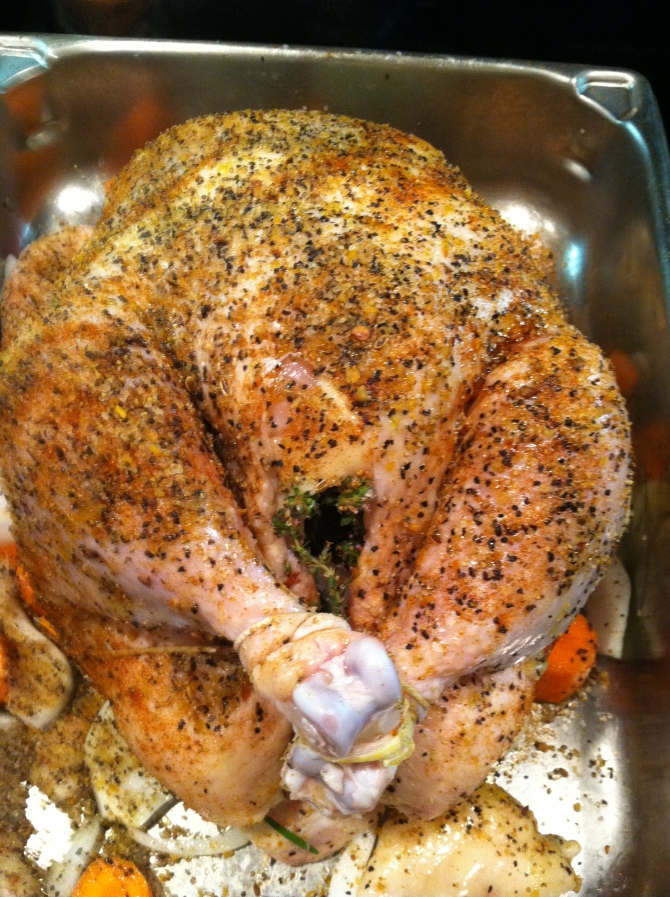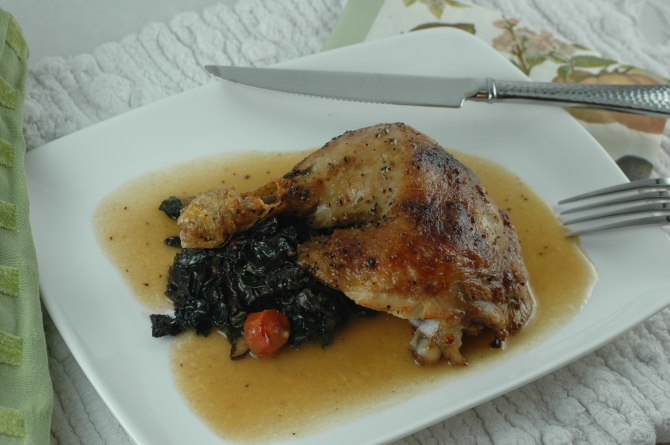 Here is another basic skills post about how to roast a chicken. The same principle applies to most birds, large or small. Ducks are just a bit different due to the amount of fat on them.
Here is another basic skills post about how to roast a chicken. The same principle applies to most birds, large or small. Ducks are just a bit different due to the amount of fat on them.
To select a whole chicken, carefully look at the wing tips, they should not be brown in any way. Slightly red is OK but no brown. Look at the neck area, same thing. These areas show age on market chickens. If they are fresh, they will be ‘chicken color’ and possibly red tips on the wings. No brown, green or purple.
The chicken should also not have any odor. Give it a sniff. Pass it by if you smell anything.
Sometimes the inside of the bird contains a small bag of the heart, liver, neck and gizzard. Remove this from the inside of the bird. Throw it away unless you eat heart, liver, neck and gizzard. My father made wonderful sauce from these parts. Sometimes I saute the hearts and livers but there is only one inside each bird so they become the cooks treat. YAY!
Thoroughly rinse the bird inside and out. Pat the bird dry.
Carefully, using your fingers, loosen the skin but do not tear it.
Insert compound butter between the skin and the meat, smoosh it around so it almost covers the meat and then rearrange the skin back in place. This will baste the meat with herbs and butter while the bird roasts.
What is compound butter? Soft butter with herbs and seasonings mixed in. Any combination, any flavors, your choice. Toss it in a mixer, mix it up, place in a container and use it anywhere you would use butter. The butter I used here contained thyme, garlic, lemon, shallot and pepper.
To give the bird some flavor while roasting, insert herbs, onion and garlic into the cavity. For this bird I used rosemary, thyme and onion and a bay leaf.
For food safety sake, if you want stuffing, bake it in a separate pan. See note below regarding food safety.
On the bottom of the roasting pan, place chopped carrots, celery and onion (25% carrots, 25% celery, 50% onion ratio) and 1/2 cup or so of water or stock.
Professionally, we call this vegetable ratio “mirepoix”.
Tie the legs together with butchers twine or cotton string. Run the string around the legs and thighs and tie it off under the wings. This holds the bird together in a nice compact bird-like shape, controls the legs and plumps the breasts.
This is how you get a good-looking finished bird that isn’t splaying its parts all over the place.
Season the birds skin. I used Montreal Steak Seasoning for this one. Season as you like.
Place the tied and stuffed bird in the roasting pan on top of the vegetables.
Roast the bird in a 350°F oven for about 2 hours or so for a 3 pound bird. Please use a thermometer to test for 180°F internal temperature in the thigh, not near a bone.
The dark meat takes longer to cook so you test there. Please be sure to cook your chicken all the way.
There is nothing as unappealing as cutting into a whole roasted bird and have blood come out. Obviously, it goes back into the oven to finish cooking, if that happens.
When the bird is done, allow it to “rest” for about 15-20 minutes before carving. This is when I prepare the vegetables and put the final touches on the meal.
Food safety really comes into play with handling chicken.
-
Keep the bird cold.
-
Sanitize the work area with a mild bleach after preparing and handling the bird.
-
We are trying to avoid contaminating our families with Salmonella and Campylobacter jejuni in particular.
-
If your bird is frozen do not allow it to thaw on the counter or in the sink. Put it under cold water that you change frequently or in the refrigerator which takes 2-3 days to thaw, so plan ahead.
-
Always sanitize everything that chicken and your hands come in contact with during preparation with a mild bleach solution when you finish. Knives, boards, spoons, counters, sinks, knobs, handles, towels, aprons, etc.
To make a sauce, use the drippings in the bottom of the roasting pan. Deglaze with chicken stock or white wine. Strain the liquid from the roasting pan into a sauce pot. Bring to a simmer.
Mix equal parts of butter and flour together in a small bowl. Drop small pea sized pearls of the flour and butter mixture into the simmering stock, whisk to incorporate. Season as desired. Simmer for 10-15 minutes to cook out the starch taste. Finish with a pat of cold butter whisked in, adjust salt and pepper. Strain again if desired.
We sautéed the beet greens we had on hand from the pickled beet post. Yummy stuff.
There will be another post soon on “How to Cut Up a Chicken”
Enjoy roasting your chickens! I adore the aroma, it smells like home and all things wonderful.
Related articles
- Chicken Again? Easy Methods to Create an Inexpensive Gourmet Chicken Recipe (notecook.com)
- Roasted Chicken: Back to Basics (cucina-e-amore.com)
- Lemon Garlic Herb Roasted Chicken (kathskitchensync.wordpress.com)
- WW Garlic Roast Chicken with Crisp Potatoes and Mushrooms (hgijanto.wordpress.com)
- Butter Roasted Chicken with Rosemary and Sage (4/25) (elleswim.net)
- Turn One Chicken into Two Roasts: A Lesson In Deboning (blogher.com)




great blog..Love the background really cool and fresh..
Thank you!
no prblem
great post! better than julia child! have to read this and comment more.
Wow, such a complement! You say the nicest things.
Thank you.
I’m making bread today and thought about your olive loaf.
love you baby! do you know how many times I tried, unsuccessfully, to roast a chicken? always nic, felt I was missing out something. and now I now I was missing out basically everything! I looked at Julia Child’s video on how to roast a chicken, and that was funny, yeap, but no way as instructive as this amazing tutorial. I almost totally stopped eating chicken, as it is almost impossible to find free-range, organic, chicken in Sweden (eggs, yes, chicken no… does it make any sense?). I may go get to the far away good and pricey meat place ONLY to make your roasted chicken. thank you Prof.
Thank you so much. it is odd you can’t find chicken (free range) in Sweden, guess the keep the chicken laying eggs rather than eating them.
I would love to see your chicken if you get one and roast it. The aroma of a roasting chicken is wonderful.
“nic”? no idea what I was trying to write there. lol. and it was “know” the second “now”. you see what your chicken does to me? makes me even forget my written English!
You are too funny!
Pingback: How to: Dressing a Chicken « Rhianna's Guide to Ethical Eating